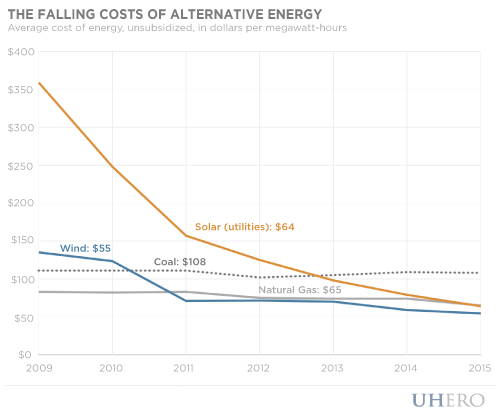By Michael Roberts
Without the debt-ceiling hijinks of earlier years, the federal budget bill passed at the end of last year with a lot less drama and press coverage. But little news turned out to be good news, at least for Hawai`i and renewable energy interests. The spending bill included an extension of the 30% tax credit for renewable energy that otherwise would have expired at the end of 2016. Under the new legislation, the tax credit will remain at 30% through the end of 2019, then step down gradually through 2021, and remain at 10% thereafter. The subsidy is especially valuable to Hawai`i because, under the State’s renewable portfolio standard, we will be ramping up renewable energy investments with or without it. That means free federal money for Hawai`i, potentially a whole lot of it, compliments of the other 49 states.
The extended subsidy, falling costs of renewable energy, plus an historic Paris Agreement, signed last month by all United Nations countries, gives great global momentum to renewable energy. A renewable-energy future now looks all too plausible, and there’s a chance it could happen fast. Even without subsidies, solar PV and wind are already competitive with coal and natural gas in the generation of electricity, and costs continue to fall. By the time federal subsidies bottom out, it appears likely that renewable energy will handily beat fossil fuels on a levelized-cost basis, not just in Hawai`i, but everywhere. Storage costs, the critical challenge for renewables, are also falling, and could fall much further as production scale increases for both electric cars and grid applications.

Renewable energy indirectly gained further momentum on the mainland from a Supreme Court ruling that upheld a rule by the Federal Energy Regulatory Commission (FERC) that forces grid operators to reward demand response at the same rates as incremental generation. The ruling should open up new markets for demand response, which in turn should improve the system-level cost effectiveness of variable and intermittent renewables. Although the ruling has no direct bearing on Hawai`i, the nascent industry of demand response systems could be helpful to our state and its renewable energy goals.
So, how can Hawai`i make the most of the situation? Part of the answer involves maximizing the benefits of extended federal subsidies, which probably means getting more renewables onto the grid sooner than later.
And part of the answer involves fully exploiting our leadership in renewable energy. Due to the high cost of imported oil and our old infrastructure, renewable energy is more economically viable here than in most places. At the same time, our isolated island economy makes the intermittency problem especially acute. But if we can do renewable energy right—which means efficiently dealing with intermittency challenges of solar and wind—it could bring economic opportunities to the State that far exceed any direct benefits from subsidies, lower dependence on imported, oil or even lower electricity bills.
The greater opportunity is that Hawai`i could become an innovation hub for new smart devices, batteries, thermal storage and perhaps other technologies that can aid demand response and can help solve intermittency challenges. Entrepreneurs should be anxious to test their new technologies in the place where they will be economical first. If new technologies are proven here, in subsequent years they will likely find much larger markets in California, other mainland states, Japan and the rest the world.
To some degree this kind of thing is already happening, but the potential is far greater. If Hawai`i can attract this kind of investment, it will bring high-skilled and high-paying jobs, along with the broader social and economic rewards that typically accompany them.
Open-Access Variable Pricing
The key to making all this happen boils down to better pricing and easy, open access to the grid. A few months ago UHERO’s Energy Policy and Planning Group argued that we should work toward a system in which anyone can buy or sell at the incremental cost of electricity generation, which varies a lot over seasons, hours of the day, and certain events, like unexpected power plant failures. While the FERC ruling does not force Hawai`i to price demand response as it does generation, we should nonetheless figure out a way to embrace the spirit of that ruling, and more.
Open-access variable pricing allows anyone to buy low and sell high, and thereby make a profit while helping to solve intermittency challenges, effectively rescheduling electricity use toward intermittent supply. Everyone benefits, whether they participate in variable pricing or not, since it lowers the overall cost of the system. Open-access variable pricing might improve efficiency a little today, but its benefits will grow much more with greater wind and PV solar penetration.
This vision stands in stark contrast to our current system in which a centralized utility adjusts supply to match time-varying demand. Demand response embraces the idea that balancing supply and demand need not be a one-sided proposition. A lot of electricity is used to heat water, pump water from aquifers and up hills to storage tanks. Perhaps as much as 40 percent of the load is used for air conditioning. All of these demand sources, and perhaps many others, could employ any number of technologies to shift electricity demand toward supply of renewables. These technologies, like smart, price forecasting water heaters, variable speed pumps and ice storage, could be automated to respond to price changes, saving money for hotels, the water utility, the military, and other large electricity customers. Such systems might even be used to stabilize short-run fluctuations in the grid, exacerbated by passing clouds and variable winds.
Savvy residential consumers might strategically time clothes washing, water heating, electric car charging and air conditioning, to save a few bucks or enjoy a cooler, more comfortable living situation when renewable energy is plentiful and prices are low. Or, more likely, engineers could build smart controllers for these machines such that they automatically run at opportune times. While this kind of residential demand response is not where the largest opportunities lie, the benefits could add up. The problem today is that, without real marginal-cost pricing for either buyers or sellers of electricity, there’s no incentive to create smart, price-forecasting controllers for appliances.
A greater potential for load shifting may lie with large-scale uses. Well over two thirds of electricity consumption on Oahu comes from commercial and industrial class customers. These large-scale users have a real stake in lowering energy cost and many already have real-time meters. It’s easy to imagine that 20-30 percent of our load might be shiftable to different times of the day. The savings could amount to the difference in cost between a 100 percent renewable systems and our conventional fossil-fuel based system.
Regardless of the potential savings, focusing on demand response first is the least-cost way to help balance a grid with a growing share of variable renewable supply. The longer we can put off investments in storage capacity, the less expensive those investments will be. And the pricing policies needed to entice demand response will provide a larger framework for optimally managing storage and the grid of the future.
Together with Matthias Fripp, Makena Coffman, and graduate students in UHERO’s Energy Policy & Planning Group, we are working to develop ballpark estimates of the potential savings. First-cut estimates indicate overall cost savings of roughly 20 percent if 30 percent of the load in each hour can be shifted to other times of the day. Looking forward, we hope to pin down more concrete estimates of shiftable loads at different times of day, season and weather-related circumstances.
I will follow this post with two more over the next couple days, one that discusses recently proposed time-of-use rates and ways they could be improved, and another discussing how we need to change incentives for our utility, Hawaiian Electric Industries, such that they better align with state goals.
Next Up: Embrace Policy Experiments for Demand Response
BLOG POSTS ARE PRELIMINARY MATERIALS CIRCULATED TO STIMULATE DISCUSSION AND CRITICAL COMMENT. THE VIEWS EXPRESSED ARE THOSE OF THE INDIVIDUAL AUTHORS. WHILE BLOG POSTS BENEFIT FROM ACTIVE UHERO DISCUSSION, THEY HAVE NOT UNDERGONE FORMAL ACADEMIC PEER REVIEW.




